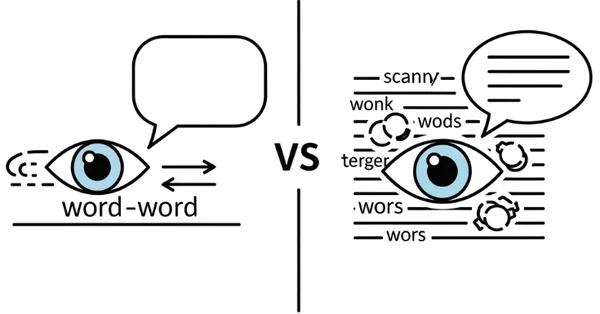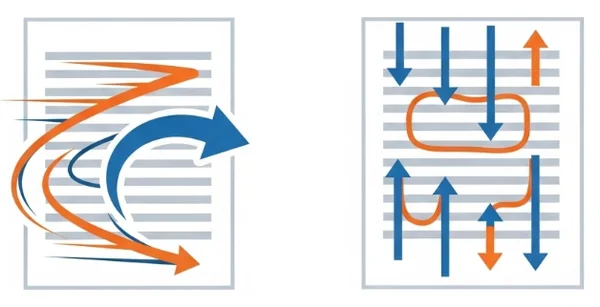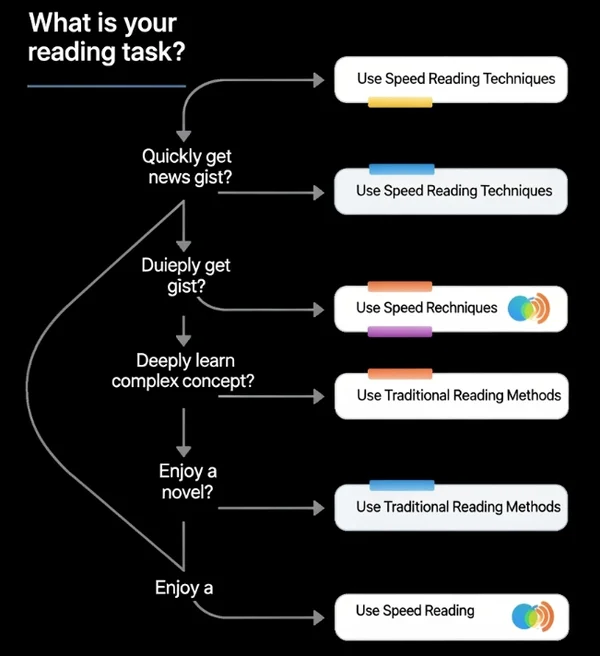What is Speed Reading? Techniques, Myths & Is It for You?
The promise of devouring books in a fraction of the time is undeniably tempting. What is speed reading, and can it truly transform your reading habits? You've likely heard claims of people reading thousands of words per minute, but does speed reading work in reality, or is it surrounded by more myth than method? This article will explore the fascinating world of speed reading, breaking down common speed reading techniques, debunking prevalent speed reading myths, and helping you determine if pursuing this skill is the right choice for your reading goals. Before you decide to learn speed reading, it's wise to understand the full picture. For a baseline of your current abilities, you might first want to check your standard reading pace with a reading speed test.
Defining Speed Reading: What Exactly Are We Talking About?
What is speed reading? At its core, speed reading encompasses a collection of methods intended to increase the rate at which a person can read text, without, ideally, a significant loss in comprehension. It's about processing written information more rapidly than conventional reading.
Speed Reading vs. Regular Reading: Key Differences
How does speed reading differ from your everyday reading experience?
-
Focus: Regular reading often involves careful word-by-word processing and subvocalization (saying words in your head).
Speed reading techniquesaim to minimize these. -
Eye Movement: Traditional readers often regress (re-read words or phrases). Speed readers train their eyes to move more smoothly and cover larger chunks of text.
-
Comprehension Goal: While regular reading prioritizes deep understanding, some
speed readingapproaches might trade a degree of comprehension for faster processing, depending on the material and purpose. This is a crucial point often debated inspeed reading vs normal readingdiscussions.

The Main Goals and Purported Benefits of Speed Reading
Proponents of speed reading highlight several potential speed reading benefits:
- Increased Efficiency: Process more information in less time.
- Time Management: Free up valuable time by reading faster.
- Handling Information Overload: Cope better with large volumes of text (e.g., emails, reports, study materials).
- Improved Focus (Potentially): Some techniques aim to enhance concentration by demanding more active engagement.
Many people seek to
learn speed readingto achieve these advantages.
Common Speed Reading Techniques Explained (How They Work)
Several speed reading techniques are commonly taught. Understanding how they aim to work is key before attempting speed reading practice.
Technique 1: Skimming – Getting the Gist Quickly
Skimming involves rapidly moving your eyes over a text to get a general overview or the main ideas. You're not reading every word but looking for keywords, headings, topic sentences, and summaries. This is useful for quickly assessing if a text is relevant or for a superficial understanding. This is a foundational speed reading skill.
Technique 2: Scanning – Finding Specific Information Fast
Unlike skimming for general meaning, scanning is used when you're looking for a particular piece of information, like a name, date, or specific fact. Your eyes sweep across the page searching for that target, ignoring other text. This is a highly efficient speed reading technique for targeted searches.

Technique 3: Pacing / Meta Guiding (e.g., Using a Finger or Pen)
This involves using a physical guide, like your finger or a pen, to lead your eyes across the text at a steady, faster-than-usual pace. The idea is to:
- Set a Rhythm: Encourage smoother eye movements.
- Reduce Regression: Minimize the habit of re-reading words.
- Maintain Focus: Keep your eyes moving forward.
This is a popular method in many
learn speed readingprograms.
Technique 4: Chunking or Phrase Reading – Seeing Groups of Words
Instead of reading word by word, chunking trains you to see and process groups of words (phrases or short sentences) at each eye fixation. This aims to widen your visual span and reduce the number of stops your eyes make per line, thereby increasing overall WPM. This is a more advanced speed reading technique.
Speed Reading Myths vs. Reality: What Does the Science Say?
It's crucial to separate the speed reading myths from the achievable realities. Does speed reading work as advertised? Scientific research offers a more nuanced perspective.
Myth: Speed Reading Means Sacrificing All Comprehension
This is one of the biggest speed reading myths. While extreme speeds (e.g., thousands of WPM) almost certainly lead to drastically reduced comprehension, moderate increases in reading speed using certain techniques may be possible with practice while maintaining reasonable understanding, especially for simpler texts or when skimming. However, there's often a trade-off: the faster you read beyond a certain point, the more comprehension is likely to suffer.

Myth: Anyone Can Read Thousands of Words Per Minute with Full Understanding
Claims of reading entire novels in minutes with perfect recall are highly exaggerated speed reading myths. The physiological limits of eye movement, visual processing, and cognitive understanding make such feats with full comprehension virtually impossible for the vast majority of people.
The Realistic Potential and Limitations of Speed Reading Techniques
Realistically, most people can improve their reading efficiency by 25-50% or even more by reducing bad habits like subvocalization and regression, and by effectively using techniques like skimming and scanning for appropriate tasks. However, achieving and maintaining significantly higher speeds (e.g., >800-1000 WPM) with strong comprehension across all types of material is very challenging and not typical. The speed reading benefits are often context-dependent.
The Pros and Cons of Learning Speed Reading
Considering whether to learn speed reading involves weighing its potential advantages against its drawbacks.
Potential Advantages: Increased Efficiency, Time Management
- Process Information Faster: Useful for reviewing familiar material or getting through large volumes of less critical text.
- Better Time Allocation: Can free up time for other tasks.
- Improved Focus (with some techniques): Pacing, for instance, can help maintain attention.
These are often cited as key
speed reading benefits.
Potential Disadvantages: Risk to Comprehension, Not Suitable for All Texts
- Reduced Comprehension: Especially for complex, dense, or unfamiliar material, or when in-depth understanding is required.
- Loss of Enjoyment: Rushing through text can diminish the pleasure of reading, especially for literature.
- Not a Universal Solution: Speed reading is not ideal for analytical reading, studying for detailed recall, or appreciating nuanced writing.
It's important to be aware of these when considering
speed reading practice.
Is Speed Reading Right for You? Considering Your Goals and Needs
The decision to learn speed reading should depend on your individual reading goals and the types of material you typically engage with.
When Speed Reading Can Be a Useful Skill (e.g., Reviewing, Skimming News)
Speed reading techniques can be beneficial for:
- Quickly reviewing notes or previously read material.
- Skimming daily news articles or blog posts for main points.
- Getting through emails or routine reports efficiently.
- Initial research to quickly identify relevant sources.
When Traditional Reading Methods Are More Appropriate
For tasks requiring deep understanding, critical analysis, or memorization, traditional, more deliberate reading methods are usually superior:
-
Studying textbooks for exams.
-
Reading legal documents or technical manuals.
-
Enjoying complex literature or poetry.
-
Learning new or difficult concepts.

Trying it Out: How a Speed Reading Test Can Offer Insights
Before diving into intensive speed reading practice, understanding your current baseline is helpful. While specific speed reading test tools exist, even a standard reading speed test like ours can show your current WPM and comprehension. This helps you gauge your starting point and decide if general reading efficiency or specific speed reading techniques are your priority.
Getting Started: Basic Speed Reading Practice Tips
If you're curious to experiment with increasing your reading pace, here are a couple of basic speed reading practice tips:
Reducing Subvocalization: Quieting the Inner Voice
Subvocalization (saying words in your head as you read) is natural but can limit reading speed to your speaking speed. Try to minimize it by:
- Focusing on visual intake.
- Using a pacer to move your eyes faster than you can "say" the words.
- Sometimes, lightly humming or chewing gum can occupy the vocal mechanism.
Practicing with Pacing Techniques Consistently
Use your finger or a pen to guide your eyes across each line, gradually increasing the pace. Consistent speed reading practice with this method can help train smoother eye movements and reduce regressions.
Speed Reading – A Tool in Your Reading Toolkit, Not a Magic Bullet
What is speed reading? It's a set of techniques aimed at increasing reading rate. While it offers potential benefits for certain tasks and can help overcome some inefficient reading habits, it's not a magical solution for all reading needs. The most extreme claims about speed reading often overshadow the realistic speed reading benefits and the critical importance of comprehension. Think of speed reading techniques as specialized tools: useful in the right context, but not a replacement for your entire reading toolkit. The key is to understand when to use them and when to rely on more traditional, comprehension-focused reading.
Have you tried any speed reading techniques? What are your thoughts on the balance between speed and understanding? Share your experiences in the comments below! And if you want to understand your current reading capabilities, a good first step is always a reliable reading speed test.
Your Top Questions About Speed Reading Answered
-
Can I really teach myself to speed read effectively?
Yes, you can
teach yourselfmany basicspeed reading techniqueslike pacing and skimming through consistentspeed reading practice. However, achieving significant, sustainable gains, especially while maintaining good comprehension, often requires structured learning and dedicated effort. Results vary greatly among individuals. -
Does speed reading actually work, or is it just a gimmick?
Does speed reading work? It's not entirely a gimmick, but its effectiveness is often overstated. Certainspeed reading techniquescan help you process text faster for specific purposes (like skimming). However, claims of reading at thousands of WPM with full comprehension are largelyspeed reading myths. A realistic approach is key. -
What's the difference between speed reading and normal reading for comprehension?
The main difference in
speed reading vs normal readinglies in the prioritization. Normal reading typically prioritizes comprehension, allowing for slower, more deliberate processing if needed.Speed readingprioritizes rate, and while some techniques aim to preserve comprehension, there's often a trade-off, especially with complex texts or at very high speeds. -
Are there any good speed reading exercises for beginners?
Good beginner
speed reading exercisesinclude:- Pacing: Using your finger to guide your eyes across lines, gradually increasing speed.
- Timed Readings: Reading for a set time (e.g., 1 minute) and counting words, then trying to beat your score on similar material.
- Peripheral Vision Expansion: Trying to take in more words at each eye stop (fixation). You can use our reading speed test to get a baseline WPM for your timed readings.
-
Will taking a speed reading test improve my speed?
Simply taking a
speed reading test(or a regularreading speed testlike ours) won't automatically improve your speed. However, it provides a crucial benchmark. Knowing your current words per minute (WPM) and comprehension level allows you to set realistic goals, track progress from yourspeed reading practice, and see if thespeed reading techniquesyou're trying are having an effect.